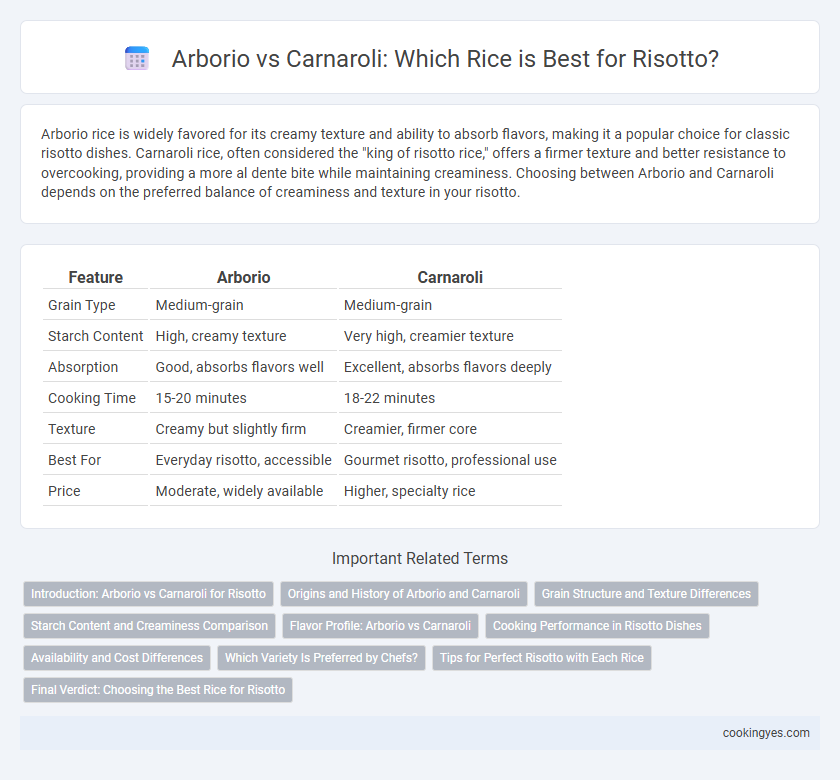Arborio rice is widely favored for its creamy texture and ability to absorb flavors, making it a popular choice for classic risotto dishes. Carnaroli rice, often considered the "king of risotto rice," offers a firmer texture and better resistance to overcooking, providing a more al dente bite while maintaining creaminess. Choosing between Arborio and Carnaroli depends on the preferred balance of creaminess and texture in your risotto.
Table of Comparison
| Feature | Arborio | Carnaroli |
|---|---|---|
| Grain Type | Medium-grain | Medium-grain |
| Starch Content | High, creamy texture | Very high, creamier texture |
| Absorption | Good, absorbs flavors well | Excellent, absorbs flavors deeply |
| Cooking Time | 15-20 minutes | 18-22 minutes |
| Texture | Creamy but slightly firm | Creamier, firmer core |
| Best For | Everyday risotto, accessible | Gourmet risotto, professional use |
| Price | Moderate, widely available | Higher, specialty rice |
Introduction: Arborio vs Carnaroli for Risotto
Arborio and Carnaroli are the two most popular Italian rice varieties used for risotto, each offering distinct textures and cooking properties. Arborio rice is known for its shorter, plumper grains and high starch content, producing a creamy, slightly chewy risotto. Carnaroli rice, often called the "caviar of rice," has longer grains and a higher amylose level, resulting in a firmer texture and better absorption of flavors, making it preferred by many chefs for a refined risotto experience.
Origins and History of Arborio and Carnaroli
Arborio rice, originating from the Po Valley in northern Italy, has been cultivated since the early 20th century and is named after the town of Arborio in the Piedmont region. Carnaroli rice, also hailing from northern Italy, specifically the Lombardy and Piedmont regions, is often called the "king of rice" due to its superior starch content and its development in the early 20th century by crossing Vialone and Lencino varieties. Both Arborio and Carnaroli have become essential staples in traditional Italian risotto recipes, reflecting their deep-rooted cultural and agricultural significance.
Grain Structure and Texture Differences
Arborio rice features shorter, plumper grains with a high starch content that produces a creamy texture ideal for traditional risotto. Carnaroli grains are longer and firmer, offering greater resistance to overcooking and maintaining a slightly al dente bite while still delivering a smooth, rich consistency. The grain structure of Carnaroli contributes to its reputation as the preferred choice among chefs seeking a perfect balance of creaminess and texture in risotto dishes.
Starch Content and Creaminess Comparison
Arborio rice contains a high level of amylopectin starch, which releases quickly during cooking, resulting in a creamy risotto texture. Carnaroli rice has an even higher starch content with a firmer grain structure, offering superior creaminess and better resistance to overcooking. This makes Carnaroli the preferred choice for chefs seeking a rich, velvety risotto with distinct, tender grains.
Flavor Profile: Arborio vs Carnaroli
Arborio rice offers a creamy texture with a mild, slightly nutty flavor, making it ideal for absorbing rich broths in risotto. Carnaroli rice provides a firmer, al dente bite and a more pronounced, buttery taste, favored for its ability to maintain structure during slow cooking. The flavor profile of Carnaroli tends to be more complex and refined, appealing to gourmet risotto recipes seeking a delicate, luxurious mouthfeel.
Cooking Performance in Risotto Dishes
Arborio rice offers a creamy texture with a slightly firm center, making it ideal for traditional risottos that require a balance between creaminess and bite. Carnaroli rice exhibits superior starch content and kernel firmness, allowing it to absorb liquids more effectively and maintain shape, which results in a more al dente texture and richer mouthfeel in risotto dishes. Both varieties excel in cooking performance, but Carnaroli is preferred by chefs seeking enhanced creaminess and structural integrity during prolonged cooking.
Availability and Cost Differences
Arborio rice is generally more available worldwide and tends to be less expensive due to its widespread cultivation and demand, making it a common choice for risotto beginners. Carnaroli rice, often referred to as the "caviar of risotto rice," is typically pricier and found mainly in Italian specialty stores, reflecting its premium quality and limited production. Chefs seeking a creamier texture and superior grain firmness often invest in Carnaroli despite its higher cost and relatively lower availability compared to Arborio.
Which Variety Is Preferred by Chefs?
Chefs often prefer Carnaroli rice for risotto due to its higher starch content and firmer texture, which provides a creamier consistency and better al dente bite. Arborio rice is widely used in home cooking for its availability and shorter cooking time but tends to release starch more quickly, resulting in a softer texture. Carnaroli is frequently called the "caviar of rice" by culinary experts for its superior absorption and resilience during slow cooking.
Tips for Perfect Risotto with Each Rice
Arborio rice absorbs liquids well and releases starch effectively, creating a creamy texture ideal for classic risotto recipes, so stir frequently and add broth gradually to avoid overcooking. Carnaroli has a firmer kernel and higher starch content, resulting in a richer, creamier risotto with distinct grains; maintaining a gentle simmer and careful timing ensures it remains al dente. Perfect risotto requires tasting often, adjusting heat to maintain a steady cook, and using quality broth for enhanced flavor with both Arborio and Carnaroli varieties.
Final Verdict: Choosing the Best Rice for Risotto
Carnaroli rice is often favored by chefs for risotto due to its higher starch content and firm texture, which creates a creamy yet al dente dish. Arborio rice remains popular for its accessibility and quicker cooking time, producing a slightly softer risotto with rich flavor absorption. For the best risotto, Carnaroli offers superior creaminess and structure, making it the preferred choice for traditional, high-quality results.
Arborio vs Carnaroli for Risotto Infographic

 cookingyes.com
cookingyes.com